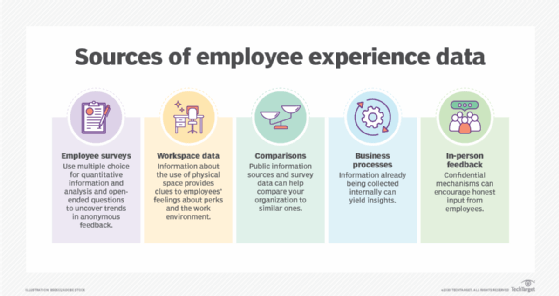
Getty Images/iStockphoto
The role of IT ops in digital employee experience management
Automated tools for measuring and analyzing employees' digital experience satisfaction can help IT ops predict problems, identify areas for improvement and cut costs.
IT operations plays a critical role in improving digital employee experience management. By measuring employees' experiences with technology, IT teams can provide valuable insights into the effectiveness of their organization's digital strategy and the performance of its IT systems.
A digital employee experience (DEX) score measures employees' satisfaction with the digital tools and technologies they use in their day-to-day work. This score is critical to IT operations because it provides information on employees' digital experiences to IT leaders, support teams and even other end users.
What makes up a DEX score?
Depending on the organization, many components can make up the overall DEX score. However, most digital employee experience platforms focus on measuring device performance, application performance and employee sentiment.
Device metrics include system and application crashes, logon time, high CPU and memory use, and disk I/O. Application performance is typically measured in terms of users' browser experience with SaaS applications, using factors such as page load time and webpage errors.
User sentiment takes into consideration a key aspect of digital employee experience management: users' perceptions of their experiences. Although it is often overlooked, user sentiment is perhaps the most important metric for understanding what affects users the most.
Metrics such as application crashes and high CPU use can try to capture users' experiences, but it can be difficult to truly know whether device resource use, for example, really affects end users' productivity. Measuring employee sentiment through surveys can yield insights by cutting through the hard metrics to get right to what employees think.

Use data to target areas for improvement
IT operations can use a DEX score to identify areas where technology is not meeting employees' needs and must be improved.
For example, if employees consistently report low satisfaction with a particular internal software application, this might indicate that the application is not user friendly or is not meeting employees' needs. IT can then take steps to improve the technology and enhance UX.
Digital employee experience platforms offer automated remediation capabilities, such as running scripts. There is a growing market for digital employee experience management tools, including the following:
- Nexthink
- Lakeside SysTrack
- Alluvio Aternity
- 1E
Decide which new technologies to develop and deploy
In addition to identifying areas for improvement, DEX scores can help IT operations determine priorities when developing and deploying new technologies.
Understanding which digital tools are critical to employees and which are not used as much enables IT personnel to focus their efforts on delivering technologies that most affect employee satisfaction and productivity. This can help IT make more strategic technology investments, ensuring that resources are focused on technologies that have the greatest impact.
Anticipate and prevent problems
Including IT operations in digital employee experience management can also yield valuable insights into the overall health of an organization's technology systems. By tracking the DEX score and taking action accordingly, IT can proactively address potential problems and ensure that technology is always supporting employees' needs.
Changes over time can show IT teams how well the organization's technology is supporting employees and whether any trends or patterns need to be addressed. For example, a declining DEX score could indicate underlying problems with the IT infrastructure that need to be addressed.
Reduce IT support costs
Improving the digital employee experience can also reduce the number of support requests IT receives related to digital tools and technologies.
When employees are provided with digital tools and know how to use them effectively and efficiently, they are less likely to encounter problems that require IT support. This leads to fewer help desk tickets and, in turn, reduced IT costs.
Improve digital employee experience management with AIOps
DEX scores can also be used as a key metric in AIOps tools, which use AI and machine learning to automate and optimize IT operations.
By incorporating the DEX score into AIOps algorithms, IT departments can automatically monitor digital employee experience and take action when scores begin to decline. For example, if the DEX score drops below a certain threshold, AIOps software could automatically alert IT staff and provide recommendations to address the issue.
Collecting and analyzing digital employee experience data with AIOps tools enables IT teams to automate technology monitoring and optimization. This can further improve the digital employee experience and drive greater productivity and efficiency across the organization.





